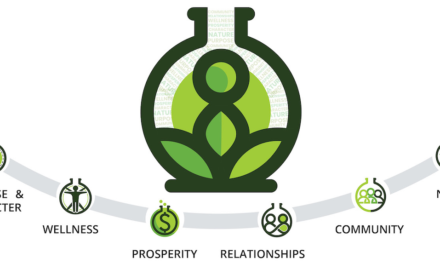Exploring the Disruptive Power of Blockchain
Exploring the Disruptive Power of Blockchain

As the Managing Director of the Ed Snider Center for Enterprise and Markets at the University of Maryland, Christina Elson is fascinated by the power of technology to solve seemingly intractable problems. Having earned a doctorate in anthropology, Elson holds a broad historical perspective of the way in which innovation prods cultures to evolve. “But while technology can correct inefficiencies in the market and give more power to consumers, it also tends to be disruptive, as it shakes up business as usual,” she says.
In her current work, Elson is trying to help individuals understand the various new technological developments that are transforming the way we live. The challenge, she insists, is to embrace rather than fear change. However, as Elson is well aware, these advances can often have a downside.
Over the past couple of years, several new additions to the tech landscape have riveted her attention including blockchain, artificial intelligence, and biotechnology. Elson has already begun exploring blockchain technology as the host of The Inc. Tank, a series of podcasts that feature interviews with leading experts around the world.
Blockchain technology is what led to the world’s first cryptocurrency, Bitcoin. In the fall of 2008, a few writers using the pseudonym Satoshi Nakamoto circulated a research paper,
“Bitcoin: A Peer-to-Peer Electronic Cash System,” on an obscure listserv in which they explained how this so-called “internet money” would work. The goal of a cryptocurrency is to enable the exchange of money directly, bypassing the need for a financial intermediary such as a bank or credit card company.
Take the example of a New Yorker named Sam, who wants to buy a painting from a Berlin art dealer named Helmut. To make the payment, Sam might withdraw some dollars from his American bank, exchange those dollars for the right amount of euros and then send a check off to Germany. Helmut, in turn, then deposits the money in his German bank before accessing it. Unfortunately, all these steps are highly inefficient, as they gobble up both time and money (via the transaction cost of exchanging the dollars into euros). Bitcoin allows Sam to pay Helmut instantly on the internet.
Bitcoin was officially launched in 2009. Since then, several other cryptocurrencies have cropped up such as Litecoin and Ethereum. While some companies—say, Expedia and Subway—now accept payment in Bitcoin, all cryptocurrencies remain a high-risk proposition, as their values still fluctuate wildly.
Blockchains rely on a distributive ledger. In contrast, most ledgers today are centralized, meaning that they are controlled by an authority. For example, Sam’s bank keeps the data on his checking account, which only he can access. But the data on the various blocks in a distributive ledger can be seen by everyone with access to the network.
The data on distributive ledgers is trustworthy because it’s impossible to erase past entries; one can only enter new blocks. If Sam were to pay Helmut for the painting with Bitcoin, he would enter the amount on the blockchain; the payment would go through because everyone could see that Sam has the necessary Bitcoin available to make the transaction.
But cryptocurrency is just one potential use of blockchain technology. As tech pioneer Marc Andreessen put it in 2014, “Bitcoin gives us, for the first time, a way for one Internet user to transfer a unique piece of digital property to another Internet user, such that the transfer is guaranteed to be safe and secure, everyone knows that the transfer has taken place, and nobody can challenge the legitimacy of the transfer. The consequences of this breakthrough are hard to overstate.”
In fact, the widespread adoption of distributive ledgers could also eventually reshape entire sectors of the economy such as health care and financial services. Likewise, blockchain technology could also radically affect all sorts of record-keeping in the years to come. We are likely to see entirely new approaches to preserving identity, intellectual property and government data and to managing supply chain operations.
Investors are now backing all sorts of start-ups using blockchain technology. “It’s like the wild west,” says Elson. “It’s a confusing time because we really don’t know which ones have any long-term staying power.” Likewise, experts worry that some players may not be legit. Says Neil Chilson, the former FTC acting Chief Technologist, who is now a research fellow at the Charles Koch Institute, in an interview on The Inc. Tank, “Old frauds may now be dressed up in new technological clothes.”
To facilitate the adoption of blockchain technology in various real-world situations, some companies are experimenting with hybrid blockchain, which falls somewhere in-between the private nature of a centralized ledger and the public nature of a distributive ledger. While the data is still decentralized and secure, it’s visible only to a select group. With hybrid blockchain, transaction times are also faster because there are fewer nodes in the blockchain. “It’s a cross between having a middle man and being totally open,” says Elson. “In some situations, someone has to verify the transactions. But then complicated questions arise about who exactly you let in and how you construct the chain.”
In the past couple of years, the tech giants have also been jumping on the blockchain wagon. As with any new technology—say, cloud computing—they want to get a piece of the action. IBM, Oracle, Amazon, SAP and Alphabet have all recently rolled out a service that helps companies develop blockchain apps.
Talking with Elson on The Inc. Tank, Ron Quaranta, Founder of the Wall Street Blockchain Alliance, a non-profit trade association that promotes the use of blockchain in the financial services industry, puts it, “Companies like IBM are now reinventing data management.”
Elson stresses that all business students need to be literate in the basics of blockchain technology. “In whatever sector they end up working,” she says, “they will need to be prepared to use it on a day-to-day basis.” She predicts that the biggest immediate impact of blockchain will be in how we handle money, noting that credit cards may be on their way out within a decade. “Some developing countries are now embracing blockchain, and they may be quicker to integrate this technology,” she adds, pointing to Dubai, which plans to conduct all government business using blockchain by 2020.
“These countries may be technologically behind us now, but they have decided to jump on the blockchain bandwagon,” says Elson.
Joshua Kendall has written on business and healthcare for numerous publications including BusinessWeek, Fortune.com, The New York Times, The Boston Globe and The Washington Post. For more about his work visit JoshuaCKendall.com.




